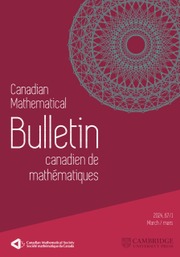Article contents
The Clifford-cyclotomic group and Euler–Poincaré characteristics
Published online by Cambridge University Press: 02 September 2020
Abstract
For an integer  $n\geq 8$ divisible by
$n\geq 8$ divisible by  $4$, let
$4$, let  $R_n={\mathbb Z}[\zeta _n,1/2]$ and let
$R_n={\mathbb Z}[\zeta _n,1/2]$ and let  $\operatorname {\mathrm {U_{2}}}(R_n)$ be the group of
$\operatorname {\mathrm {U_{2}}}(R_n)$ be the group of  $2\times 2$ unitary matrices with entries in
$2\times 2$ unitary matrices with entries in  $R_n$. Set
$R_n$. Set  $\operatorname {\mathrm {U_2^\zeta }}(R_n)=\{\gamma \in \operatorname {\mathrm {U_{2}}}(R_n)\mid \det \gamma \in \langle \zeta _n\rangle \}$. Let
$\operatorname {\mathrm {U_2^\zeta }}(R_n)=\{\gamma \in \operatorname {\mathrm {U_{2}}}(R_n)\mid \det \gamma \in \langle \zeta _n\rangle \}$. Let  $\mathcal {G}_n\subseteq \operatorname {\mathrm {U_2^\zeta }}(R_n)$ be the Clifford-cyclotomic group generated by a Hadamard matrix
$\mathcal {G}_n\subseteq \operatorname {\mathrm {U_2^\zeta }}(R_n)$ be the Clifford-cyclotomic group generated by a Hadamard matrix  $H=\frac {1}{2}[\begin {smallmatrix} 1+i & 1+i\\1+i &-1-i\end {smallmatrix}]$and the gate
$H=\frac {1}{2}[\begin {smallmatrix} 1+i & 1+i\\1+i &-1-i\end {smallmatrix}]$and the gate  $T_n=[\begin {smallmatrix}1 & 0\\0 & \zeta _n\end {smallmatrix}]$. We prove that
$T_n=[\begin {smallmatrix}1 & 0\\0 & \zeta _n\end {smallmatrix}]$. We prove that  $\mathcal {G}_n=\operatorname {\mathrm {U_2^\zeta }}(R_n)$ if and only if
$\mathcal {G}_n=\operatorname {\mathrm {U_2^\zeta }}(R_n)$ if and only if  $n=8, 12, 16, 24$ and that
$n=8, 12, 16, 24$ and that  $[\operatorname {\mathrm {U_2^\zeta }}(R_n):\mathcal {G}_n]=\infty $ if
$[\operatorname {\mathrm {U_2^\zeta }}(R_n):\mathcal {G}_n]=\infty $ if  $\operatorname {\mathrm {U_2^\zeta }}(R_n)\neq \mathcal {G}_n$. We compute the Euler–Poincaré characteristic of the groups
$\operatorname {\mathrm {U_2^\zeta }}(R_n)\neq \mathcal {G}_n$. We compute the Euler–Poincaré characteristic of the groups  $\operatorname {\mathrm {SU_{2}}}(R_n)$,
$\operatorname {\mathrm {SU_{2}}}(R_n)$,  $\operatorname {\mathrm {PSU_{2}}}(R_n)$,
$\operatorname {\mathrm {PSU_{2}}}(R_n)$,  $\operatorname {\mathrm {PU_{2}}}(R_n)$,
$\operatorname {\mathrm {PU_{2}}}(R_n)$,  $\operatorname {\mathrm {PU_2^\zeta }}(R_n)$, and
$\operatorname {\mathrm {PU_2^\zeta }}(R_n)$, and  $\operatorname {\mathrm {SO_{3}}}(R_n^+)$.
$\operatorname {\mathrm {SO_{3}}}(R_n^+)$.
MSC classification
Information
- Type
- Article
- Information
- Copyright
- © Canadian Mathematical Society 2020
References
- 4
- Cited by


